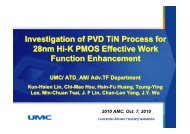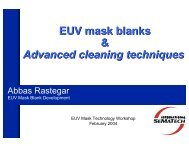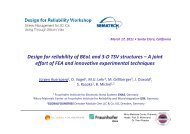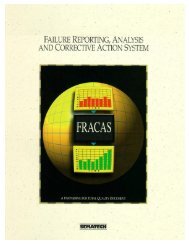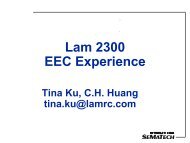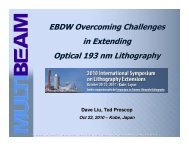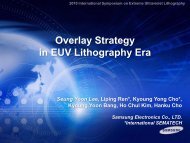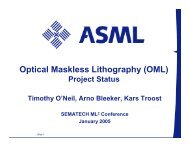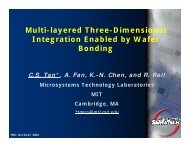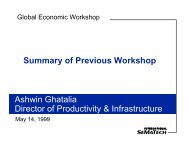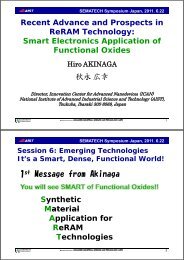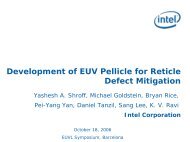Novel Ozone-based Cleaning Technique for EUV Optics ... - Sematech
Novel Ozone-based Cleaning Technique for EUV Optics ... - Sematech
Novel Ozone-based Cleaning Technique for EUV Optics ... - Sematech
You also want an ePaper? Increase the reach of your titles
YUMPU automatically turns print PDFs into web optimized ePapers that Google loves.
<strong>Novel</strong> <strong>Ozone</strong>-<strong>based</strong> <strong>Cleaning</strong> <strong>Technique</strong> <strong>for</strong><br />
<strong>EUV</strong> Masks and <strong>Optics</strong> Carbon Contamination<br />
Toshihisa Anazawa, Yasushi Nishiyama † , Noriaki Takagi,<br />
Osamu Suga, Iwao Nishiyama<br />
MIRAI-Semiconductor Leading Edge Technologies, Inc.<br />
Toshinori Miura<br />
MEIDENSHA CORPORATION<br />
† present affiliation: TOPPAN PRINTING CO.,LTD.
Contamination Contamination on on <strong>EUV</strong> <strong>EUV</strong> optics<br />
optics<br />
degrades degrades reflectivity<br />
reflectivity<br />
and and must must be be be cleaned.<br />
cleaned.<br />
Method<br />
Oxygen Plasma<br />
Hydrogen Plasma<br />
<strong>EUV</strong>+Gas (O 2 )<br />
UV<strong>Ozone</strong><br />
A carbon contamination sample<br />
on the SFET illumination mirror.<br />
(after ~9 months of use)<br />
H-Radical<br />
(W-fil. cracking)<br />
Shielded Plasma<br />
Rate<br />
Experimental<br />
Experimental<br />
Cleanability Test:<br />
Sample: C/Si-Wafer<br />
C-deposition: SEM with Phenanthrene (C 10 H 10 ) gas;<br />
Area=1 m; Electron dose=6 ~ 600×10 18 e - •cm -2<br />
<strong>Cleaning</strong>:<br />
<strong>Ozone</strong>-<strong>based</strong> dry process with 100% pure ozone<br />
generated by MEIDENSHA's pure ozone generator<br />
Evaluation: AFM (Be<strong>for</strong>e and after processing)<br />
Damage Test:<br />
Reflectivity (Reflectometer)<br />
Ru-alloy cap. ML Si cap. ML<br />
Oxidation (XPS)<br />
Ru-alloy cap. ML Si cap. ML<br />
TaBN LR-TaBN TaSi LRTaSi<br />
<strong>EUV</strong>L <strong>EUV</strong>L Symposium Symposium 2009 2009<br />
3
Merits of gas addition<br />
No light irradiation<br />
No kinetic damage<br />
No thermal damage<br />
Ethylene<br />
Ethylene<br />
Gas Gas Addition Addition Method<br />
Method<br />
MEIDENSHA's<br />
MEIDENSHA's<br />
MEIDENSHA's<br />
pure pure pure ozone ozone generator<br />
generator<br />
•O 3 generation<br />
Pure Pure O O3<br />
~100 100 %<br />
%<br />
•O 3 condensation<br />
•evaporation<br />
~100 100 100 100 100 Pa<br />
Pa<br />
Pa<br />
Pa<br />
C C H<br />
Extraordinarily Extraordinarily reactive reactive reactive agents agents are are are generated generated by by O O3<br />
×C2H4 reaction.<br />
+O +O +O3<br />
But, actual agents and processes are still unknown.<br />
primary<br />
ozonide<br />
Exhaust<br />
Exhaust<br />
via via combustion<br />
combustion<br />
abatement abatement system system<br />
system<br />
<strong>EUV</strong>L <strong>EUV</strong>L Symposium Symposium 2009 2009<br />
4<br />
R<br />
O O O<br />
C C H<br />
R<br />
C O O O C H - +<br />
R<br />
・O O ?<br />
?<br />
unsatulated<br />
hydrocarbon<br />
ozone<br />
・O H H ?<br />
?<br />
・H H ?<br />
?<br />
misc. radicals<br />
"<strong>Novel</strong> "<strong>Novel</strong> Plasmaless Plasmaless Plasmaless Photoresist Photoresist Removal Removal Method Method in in gas gas Phase Phase at at Roo Room Roo m Temperature", Temperature", T. T. Miura Miura et et al., al., 921, 921, 215th ECS Meeting (2009).<br />
(2009).<br />
?<br />
some<br />
candidates<br />
of reactant
Room Room Temperature Temperature (1 (1 min)<br />
min)<br />
Cleanability<br />
Cleanability<br />
Initial Initial Initial<br />
Processed<br />
Processed<br />
100 100 °C C (1 (1 min)<br />
min)<br />
Thickness (nm)<br />
Thickness (nm)<br />
1000<br />
800<br />
600<br />
400<br />
200<br />
1000<br />
800<br />
600<br />
400<br />
200<br />
<strong>EUV</strong>L <strong>EUV</strong>L Symposium Symposium 2009 2009<br />
5<br />
0<br />
0<br />
Be<strong>for</strong>e<br />
After<br />
Carbon Carbon have removed by 70~80 70~80 70~80 70~80 nm/min nm/min. nm/min<br />
nm/min. nm/min<br />
Initial Initial Initial<br />
Processed<br />
Processed<br />
Removed<br />
Be<strong>for</strong>e<br />
After<br />
Removed<br />
Carbon Carbon have removed by 150~250 150~250 150~250 150~250 nm/min nm/min. nm/min<br />
nm/min. nm/min<br />
250<br />
200<br />
150<br />
100<br />
50<br />
0<br />
250<br />
200<br />
150<br />
100<br />
50<br />
0<br />
Removed (nm)<br />
Removed (nm)
Be<strong>for</strong>e<br />
After<br />
10<br />
*<br />
0<br />
-10<br />
Position (mm)<br />
65<br />
64<br />
63<br />
62<br />
61<br />
60<br />
Reflectivity (%)<br />
Reflectivity<br />
Reflectivity<br />
Reflectivity Reflectivity Reflectivity Change Change Change after after after 1 1 min min min of of of Processing<br />
Processing<br />
Processing<br />
Si Si capped capped ML<br />
ML<br />
Be<strong>for</strong>e<br />
After<br />
10<br />
-10<br />
Ru Ru-alloy Ru alloy capped capped ML<br />
0<br />
65<br />
64<br />
63<br />
62<br />
61<br />
60<br />
Position (mm)<br />
Reflectivity (%)<br />
Reflectivity (%)<br />
Reflectivity (%)<br />
70<br />
60<br />
50<br />
40<br />
30<br />
20<br />
10<br />
0<br />
70<br />
60<br />
50<br />
40<br />
30<br />
20<br />
10<br />
0<br />
* Initial Initial data was not not measured at at point 0 0 <strong>for</strong> Ru Ru-alloy Ru<br />
alloy alloy<br />
thus thus thus the the the average average value value of of 10 10 and and -10 10 is plotted.<br />
Correspond to 70~80 nm of carbon film removal.<br />
13.1 13.6 14.1<br />
Wavelength (nm)<br />
13.0 13.5 14.0<br />
Wavelength (nm)<br />
Average Average<br />
Average<br />
Processed<br />
Reference<br />
No degradation was observed.<br />
No degradation was observed.<br />
Processed<br />
Reference<br />
be<strong>for</strong>e<br />
63.6 %<br />
63.6 %<br />
be<strong>for</strong>e<br />
63.7 %<br />
63.4 %<br />
diff.*<br />
-1.8 %<br />
<strong>EUV</strong>L <strong>EUV</strong>L Symposium Symposium 2009 2009<br />
6<br />
-<br />
after<br />
64.0 %<br />
63.7 %<br />
after<br />
61.9 %<br />
~2 % of reflectivity down.<br />
~2 % of reflectivity down.<br />
diff.*<br />
+0.4 %<br />
+0.1 %<br />
* Measurement errors and secular changes are included.<br />
Average<br />
Average<br />
* Measurement errors and secular changes are included.<br />
included.<br />
-
Oxidation Oxidation<br />
Oxidation<br />
Oxidation Oxidation State State Change Change after after 1 1 and and 1+2=3 1+2=3 min min Processing<br />
Processing<br />
Atomic Atomic %<br />
%<br />
Correspond to 70~80 nm (1min) and 210~240 nm (1+2 = 3min) of carbon film removal, respectively.<br />
Si capped ML (Si oxidation state)<br />
60<br />
40<br />
20<br />
0<br />
Si Si Si<br />
Si<br />
Si<br />
Si 4+<br />
Si +<br />
Si Si 2+ Si Si 3+<br />
Oxidation Oxidation Oxidation Oxidation State State State State<br />
Si<br />
Si<br />
SiO SiO SiO2<br />
1<br />
0<br />
1+2 1+2 1+2 1+2<br />
Estimated Estimated SiO<br />
SiO2 Thickness* Thickness* (nm)<br />
(nm)<br />
3<br />
2<br />
1<br />
0<br />
Time Time Time Time (min) (min) (min) (min)<br />
A A small growth<br />
(0.4 nm ~ 2 atomic layers/3 min)<br />
of oxide layer is observed<br />
but it seems to tend to be saturated.<br />
The The growth is expected to stop when the<br />
thickness reaches the maximum thickness<br />
of natural oxide. (usual 2~3 nm thick)<br />
*Calculated from escape depth of the photoelectron of Si<br />
assuming uni<strong>for</strong>m SiO 2 surface layer on the bulk Si.<br />
Si cap ML is durable against our new process.<br />
Si cap ML is durable against our new process.<br />
<strong>EUV</strong>L <strong>EUV</strong>L Symposium Symposium 2009 2009<br />
7
Oxidation Oxidation<br />
Oxidation<br />
Oxidation Oxidation State State Change Change after after 1 1 and and 1+2=3 1+2=3 min min Processing<br />
Processing<br />
Correspond to 70~80 nm (1min) and 210~240 nm (1+2 = 3min) of carbon film removal, respectively.<br />
Ru-alloy capped ML (Ru oxidation state)<br />
Atomic Atomic %<br />
%<br />
60<br />
40<br />
20<br />
0<br />
Ru<br />
Ru<br />
4+<br />
6+<br />
Ru4+ Ru 6+<br />
(min) (min) (min) (min)<br />
1+2 1+2 1+2 1+2<br />
1<br />
0<br />
Oxidation State of Ru.<br />
Si/Ru Si/Ru Ratio Ratio<br />
0.5<br />
0.4<br />
0.3<br />
0.2<br />
0.1<br />
0<br />
90 90° 90<br />
45 45°30 45<br />
30 30° 30<br />
(min) (min) (min) (min)<br />
1+2 1+2 1+2 1+2<br />
1<br />
0<br />
Si/Ru Ratio by Angle-Resolved XPS.<br />
Weighted* Weighted* Si Si Oxide<br />
Oxide<br />
(arb. (arb. units)<br />
units)<br />
90 90° 90<br />
45 45°30 45<br />
30 30° 30<br />
(min) (min) (min) (min)<br />
1+2 1+2 1+2 1+2<br />
1<br />
0<br />
Weighted* Ratio of Si Oxide.<br />
*Weight: Weight:<br />
SiO 2 2<br />
Si (3) 3/2<br />
Si (2) 1<br />
Si (1) 1/2<br />
Ru is oxidized and oxidation proceeds with process time. (left fig.) fig.)<br />
The ratio of Si/Ru increases with process time. (middle fig.)<br />
Si oxide near surface increases with process time. (right fig.)<br />
loss of Ru and/or surface segregation of Si. (Sublimation Pressure Pressure<br />
of Ru 8+ is high.)<br />
Ru-alloy cap is not durable against our new process.<br />
Some process tuning or oxidation resistant capping<br />
layer is disired (if Si cap is not suitable).<br />
<strong>EUV</strong>L <strong>EUV</strong>L Symposium Symposium 2009 2009<br />
8
Oxidation Oxidation<br />
Oxidation<br />
Oxidation Oxidation Oxidation State State Change Change after after after 1 1 min min min Processing<br />
Processing<br />
Low Low Low-Reflection Low Reflection Layers<br />
Normalized<br />
Normalized<br />
Intensity Intensity<br />
LR LR-TaBN LR<br />
TaBN<br />
Ta Ta 4f<br />
4f<br />
0 0 min<br />
min<br />
1 1 min<br />
min<br />
34<br />
32<br />
30<br />
28<br />
26<br />
24<br />
22<br />
20<br />
18<br />
Binding Binding Energy Energy (eV) (eV)<br />
(eV)<br />
Absorbers Absorbers<br />
Ta Ta of of TaBN TaBN absorber<br />
absorber<br />
Atomic Atomic %<br />
%<br />
80<br />
60<br />
40<br />
20<br />
0<br />
5/2<br />
5/2<br />
7/2<br />
7/2<br />
Ta, Ta Ta-B Ta<br />
TaOx, TaOx, TaOx, TaOx, Ta Ta-N Ta<br />
Ta 2O5 1 1 1 1 min min min min<br />
0 0 0 0 min min min min<br />
Normalized<br />
Normalized<br />
Intensity<br />
Intensity<br />
Atomic Atomic %<br />
%<br />
80<br />
60<br />
40<br />
20<br />
0<br />
LRTaSi<br />
LRTaSi<br />
Ta Ta 4f<br />
4f<br />
5/2<br />
5/2<br />
0 0 min<br />
min<br />
1 1 min min<br />
min<br />
34<br />
32<br />
30<br />
28<br />
26<br />
24<br />
22<br />
20<br />
18<br />
Binding Binding Energy Energy (eV)<br />
(eV)<br />
Ta Ta of of TaSi TaSi absorber<br />
absorber<br />
Ta, Ta Ta-Si Ta<br />
Si Si Si<br />
TaOx TaOx TaOx TaOx<br />
Ta 2O5 7/2 7/2<br />
7/2<br />
Ta Ta Ta metal metal<br />
metal<br />
(if (if (if exists)<br />
exists)<br />
5+ Ta 5+<br />
Ta<br />
Ta<br />
1 1 1 1 min min min min<br />
0 0 0 0 min min min min<br />
Correspond to 70~80 nm of carbon film removal.<br />
Ta Ta metal*<br />
metal*<br />
(if (if exists)<br />
exists)<br />
Ta in LR-TaBN LR TaBN and LRTaSi<br />
are almost fully oxidized<br />
from the beginning<br />
and was not affected<br />
by the process.<br />
Spectra Spectra <strong>for</strong> <strong>for</strong> LRTaSi LRTaSi (right (right panel) panel) seems seems broadened<br />
broadened<br />
because because of of the the charge charge-up charge up effect.<br />
*Baseline Baseline rises in LRTaSi spectra but it is not the signal<br />
signal<br />
of of Ta Ta metal metal because because no no 4f 4f 5/2 5/2 - 7/2 structure is seen.<br />
Ta in TaBN also showed no change.<br />
Ta in TaSi tend to be oxidized a little.<br />
LR-TaBN is durable against our new process.<br />
LRTaSi needs more examinations.<br />
<strong>EUV</strong>L <strong>EUV</strong>L Symposium Symposium 2009 2009<br />
9
Summary Summary<br />
Summary<br />
Cleanability<br />
Using novel ozone <strong>based</strong> cleaning technique, emulated<br />
carbon contamination film was removed efficiently.<br />
The removal rate exceeds 70 nm/min at room temperature<br />
and accelerated to 150~200 nm/min at 100 °C.<br />
Damage<br />
Reflectivity did not degrade <strong>for</strong> Si capped ML mirror<br />
but ~2 % down <strong>for</strong> Ru-alloy cap. with 1 min of processing.<br />
On mask materials, oxide-like anti-reflective layer and<br />
TaBN seemed stable to our new process.<br />
In conclusion, our new process could be applicable to<br />
Si-cap. mirror and Si-cap. mask with LR-TaBN absorber;<br />
but some tuning will be needed <strong>for</strong> Ru-alloy cap. optics.<br />
This Work was Supported by NEDO*<br />
(*New Energy and Industrial Technology Development Organization)<br />
<strong>EUV</strong>L <strong>EUV</strong>L Symposium Symposium 2009 2009<br />
10



